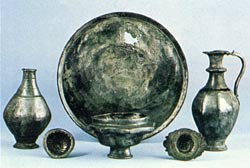![]()
The contents on this page remain on our website for informational purposes only.
Content on this page will not be reviewed or updated.
![]()
The contents on this page remain on our website for informational purposes only.
Content on this page will not be reviewed or updated.
|
THE ROMANS (55 B.C. to 450 A.D.) |
||||
|
Stony Stratford in Roman times
The town that is now called Stony Stratford is situated along Watling Street, a major Roman highway from London to Holyhead (via Chester - Deva on the map, right), and stood more or less halfway between the Roman settlements of Lactodorum (now called Towcester) and Magiovinium (now Fenny Stratford) and was important even then as a crossing point on the River Ouse. The flood plains and marshland around Stony Stratford made traversing this area tricky in bad weather. |
 |
|||
Fifty two miles from London, Watling Street had to cross the River Ouse which was then not a disciplined narrow river, but a wide flood plain through which the various channels of the Ouse meandered sluggishly. The Romans almost certainly built a causeway over the greater part of the flood plain, and possibly a bridge or bridges over the main channels, but the causeway itself would have been liable to flooding in winter. However, evidence of this has never been excavated from the site itself. |
||||
 Consequently on both sides of the Ouse there arose the village of Stani Strata-ford and Fore or Old Strataford. As the Old English 'Straetford' means a ford by which a Roman road crosses a river, we can conclude that all 'Stratfords' were on Roman roads. The name Stony Stratford therefore means "the Ford on the Stone Street" in Roman. Consequently on both sides of the Ouse there arose the village of Stani Strata-ford and Fore or Old Strataford. As the Old English 'Straetford' means a ford by which a Roman road crosses a river, we can conclude that all 'Stratfords' were on Roman roads. The name Stony Stratford therefore means "the Ford on the Stone Street" in Roman.The Romans would have passed through Stony Stratford even though it was not yet a town, nor do we even know if it had a definite name then. Stony Stratford was a stop-off point offering the traveller food, accommodation, horses, the services of blacksmiths and really anything the pilgrim or traveller might need. In that respect it laid the foundations of its later importance as a town which catered for the coaching trade. |
||||
| Roman pottery, coins, silver and other artefacts have been found, and it has been suggested that there may well have been a military post at Stony Stratford. Romans would have marched through the countryside in legions, passing along the long straight road of Watling Street, now the A5 and over the River Ouse on their way North. In 1798 Roman Silver plates and an Urn dating back to Roman times were found in Windmill Field. These pieces are now in the British Museum. They were similar to those in the illustration shown here. |
 |
|||
  The Roman road of Watling Street was primarily a military road - one of the two great roads from Londinium (London) to the North. Legions passed along it on their way to and from campaigns or re-assignments to the various garrisons around the newly conquered country. The Roman road of Watling Street was primarily a military road - one of the two great roads from Londinium (London) to the North. Legions passed along it on their way to and from campaigns or re-assignments to the various garrisons around the newly conquered country.
Anyone standing near the ford at Stony Stratford would have been used to the spectacle of disciplined marching cohorts of Roman infantry negotiating the river crossing, heading north or south. The illustrations depict a Centurion (left) and a Legionnaire (right). |
||||

Although there is no current evidence of Roman buildings in Stony Stratford itself, Roman villas have been excavated in the area, principally at Cosgrove and Bancroft. Links to these sites will be added to this page when those sites come on-line. |
||||
|
|
||||
|
|
||||